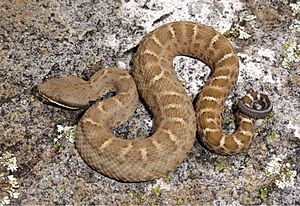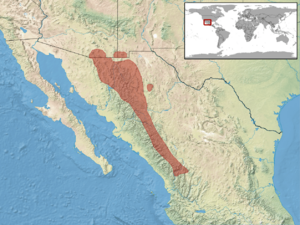Crotalus willardi facts for kids
Quick facts for kids Crotalus willardi |
|
|---|---|
 |
|
| Conservation status | |
| Scientific classification | |
| Genus: |
Crotalus
|
| Species: |
willardi
|
 |
|
| Synonyms | |
|
|
The Crotalus willardi is a special kind of venomous snake known as a pit viper. It's often called the ridge-nosed rattlesnake because of a unique ridge on its nose! You can find this snake in the southwestern United States and Mexico, especially in cool mountain areas called "sky islands." Good news: the IUCN says this snake is doing well and is of "Least Concern," meaning it's not currently threatened. It's even the official state reptile of Arizona!
Contents
What's in a Name?
The scientific name, willardi, honors the person who first found this snake. His name was Frank Cottle Willard. He was a businessman from a town called Tombstone, Arizona.
Meet the Family: Rattlesnake Subspecies
Crotalus willardi was discovered in 1905. It was the newest rattlesnake species found in the United States at that time. Today, scientists recognize five different types, or subspecies, of this snake. One of these is called Crotalus willardi willardi. This specific type is known as the Arizona ridge-nosed rattlesnake. It's also the official state reptile of Arizona.
What Does It Look Like?
The ridge-nosed rattlesnake is a fairly small snake. Most of them grow to be about one to two feet (30–60 cm) long. Their skin usually has a dark brown color with light or white stripes going across. The exact colors can be a bit different depending on the subspecies. This snake is easy to recognize because of the clear ridge on its snout. This ridge is made by scales that turn up on the end of its nose.
Where Do They Live?
You won't often find C. willardi in low-lying areas. These snakes prefer to live in high places, like wooded mountain ranges. They are mostly found in the southwestern parts of the United States and Mexico. Each subspecies lives in specific mountain ranges. This makes it quite rare for people to come across them.
How Are They Doing?
The C. willardi species is listed as "Least Concern" by the IUCN. This means they are not currently in danger of disappearing. This is because they live in many places and seem to have a large population. Their numbers were stable when checked in 2007.
However, one of the five subspecies, the New Mexico ridge-nosed rattlesnake (C. w. obscurus), is in trouble. It is listed as threatened by the US Fish and Wildlife Service. This subspecies lives in parts of New Mexico, Arizona, and northern Mexico. Their numbers are going down because their homes are being destroyed. Efforts are being made to protect their living areas.
What Do They Eat and How Do They Hunt?
Rattlesnakes are usually ambush hunters. This means they coil up and wait quietly for their food to come close. Once prey is near, they strike quickly! The ridge-nosed rattlesnake eats small mammals, lizards, birds, and even large centipedes. Young snakes mostly eat large centipedes and lizards. Adult snakes prefer mammals and birds.
How Do They Have Babies?
Like other rattlesnakes, C. willardi gives birth to live young. They do not lay eggs outside their body. Instead, the baby snakes grow inside eggs within the mother's body until they are ready to be born. Mating happens from late summer to early fall. The mother snake carries the babies for about four to five months. Females usually give birth to two to nine young, with five being the average, in late July or August. Both male and female snakes can start having babies when they are about 16 inches (400 mm) long. While snakes in zoos might have babies every year, wild females probably reproduce every two or three years.
Is Their Venom Dangerous?
Because C. willardi is a small snake, it doesn't have a lot of venom. Their venom mostly affects blood and tissues, but it's not as dangerous as the venom from some other rattlesnakes. There have been no reported deaths from a ridge-nosed rattlesnake bite. However, a bite can still cause pain and discomfort.
Types of Ridge-Nosed Rattlesnakes
| Subspecies | Taxon author | Common name | Geographic range |
|---|---|---|---|
| C. w. amabilis | Anderson, 1962 | Del Nido ridge-nosed rattlesnake | Found in north-central Chihuahua, Mexico |
| C. w. meridionalis | Klauber, 1949 | Southern ridge-nosed rattlesnake | Lives in southern Durango and southwestern Zacatecas, Mexico |
| C. w. obscurus | Harris & Simmons, 1974 | New Mexico ridge-nosed rattlesnake | Found in extreme southeastern Arizona and extreme southwestern New Mexico in the US. Also in extreme northwestern Chihuahua and extreme northeastern Sonora, Mexico |
| C. w. silus | Klauber, 1949 | Chihuahuan ridge-nosed rattlesnake | Lives in western Chihuahua and eastern Sonora, Mexico |
| C. w. willardi | Meek, 1905 | Arizona ridge-nosed rattlesnake | Found in southeastern Arizona, US, and northern Sonora, Mexico |


